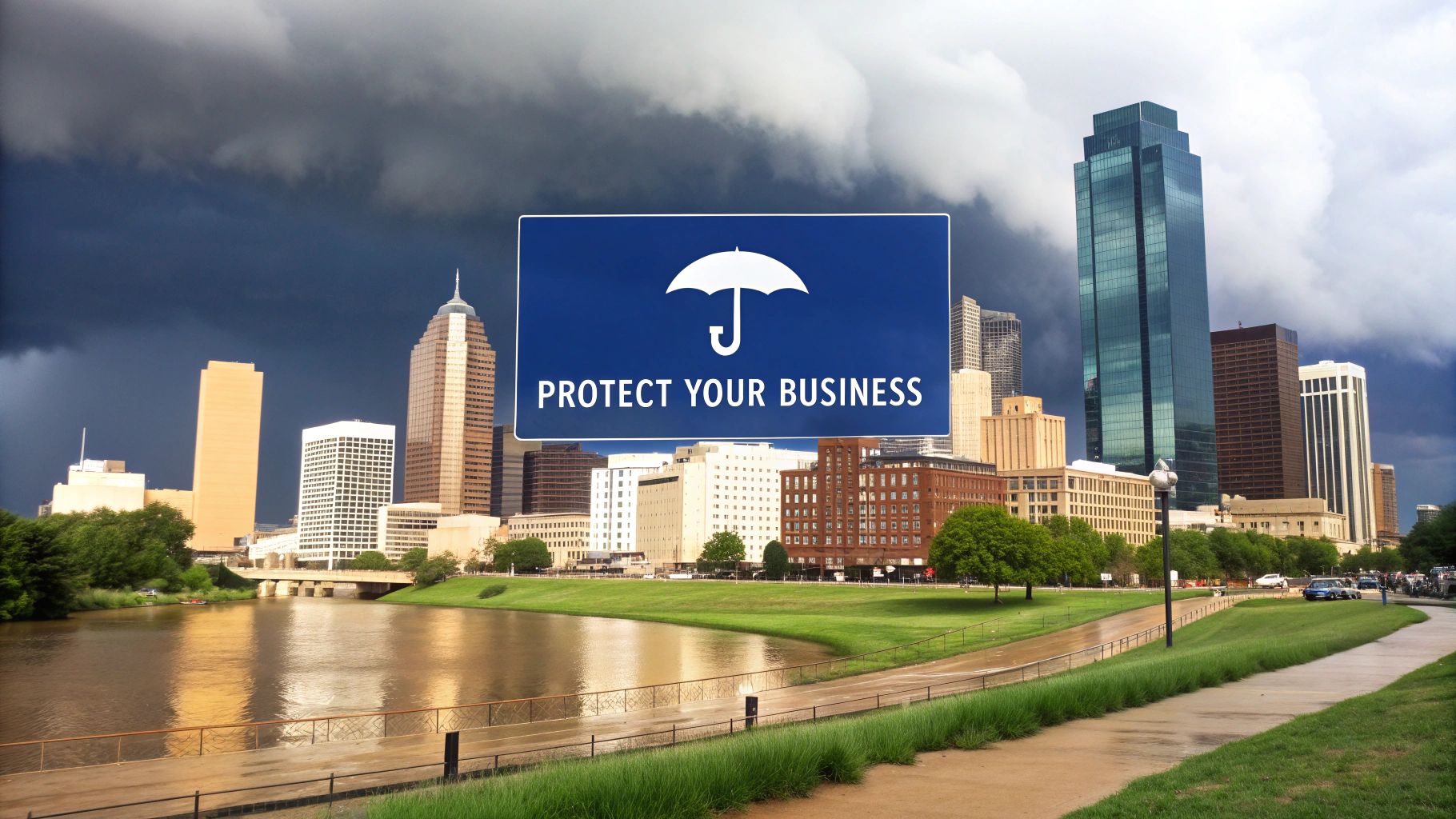For decision-makers in Texas's core industries, understanding insurance for natural disasters has evolved from a budgetary line item to a critical component of operational strategy. As the frequency and intensity of extreme weather events increase, a proactive approach to risk management is essential for business continuity and resilience.
This guide provides data-driven insights to help executives in Texas's Energy, Manufacturing, Logistics, Agriculture, and Construction sectors assess their risks and prepare for the financial impact of natural disasters, without promoting specific insurance products.
The New Reality of Operational Risk in Texas
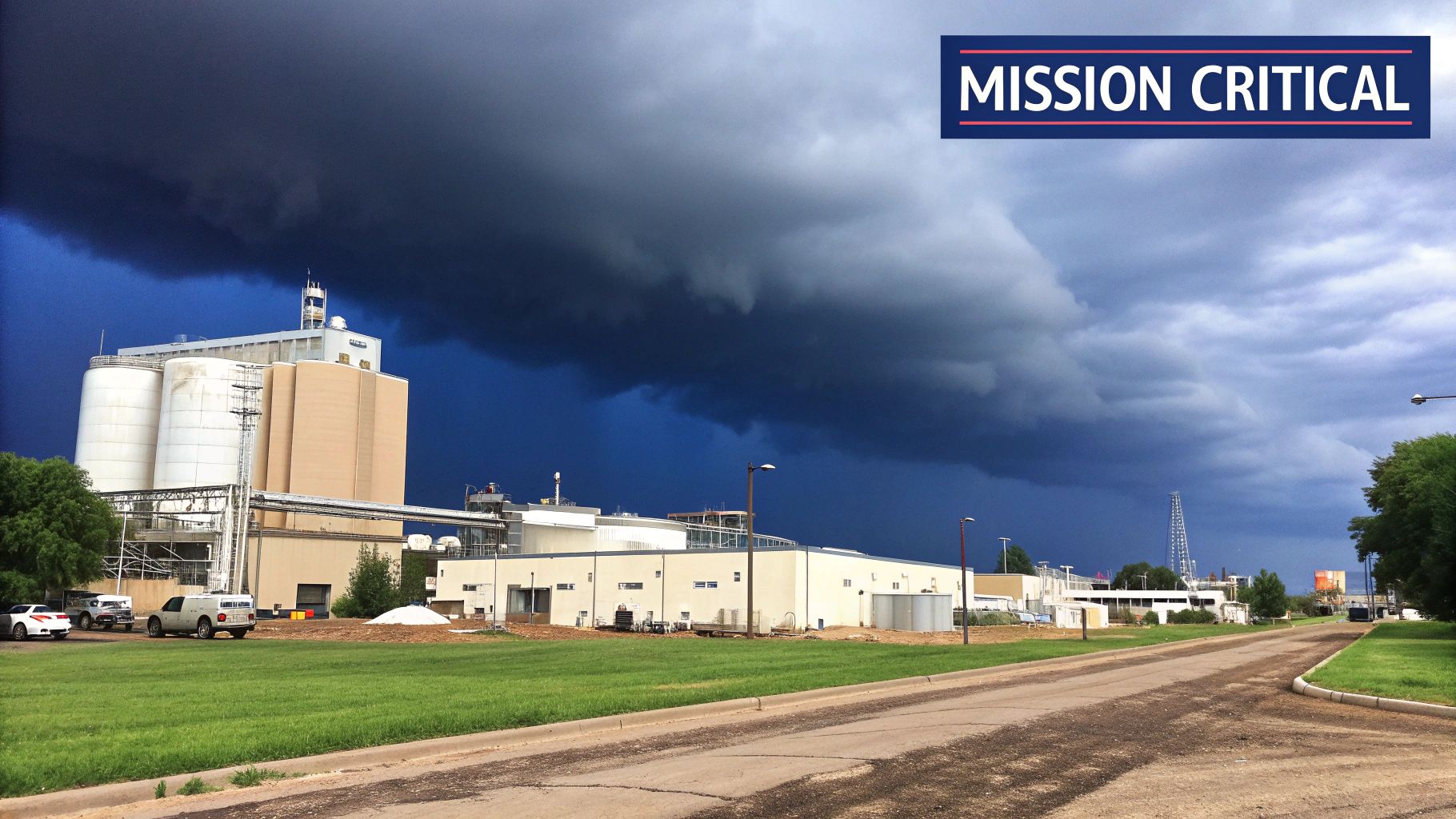
For Texas-based industries like Energy & Petrochemical, Manufacturing, and Logistics, increasing climate volatility is reshaping the operational landscape. Events once considered rare, such as "once-in-a-century" storms, are now recurring threats that make a sophisticated understanding of natural disaster insurance more critical than ever.
The financial stakes are escalating. In the first half of 2023 alone, insured losses from natural disasters reached a global total of $50 billion, significantly exceeding the 10-year average of $33 billion. This marks the fourth consecutive year global insured losses have surpassed $50 billion in the first half of the year—a persistent and costly trend with direct implications for Texas businesses.
These are not distant global issues; they have direct, tangible impacts on Texas operations. A hurricane on the Gulf Coast can halt petrochemical production for weeks. A flash flood in Central Texas can paralyze logistics hubs. A severe winter storm can disrupt the state's power grid, as demonstrated by Winter Storm Uri. These events cause not only direct physical damage but also significant business interruption that creates economic ripple effects.
From Afterthought to Strategic Imperative
Insurance can no longer be viewed as a simple compliance requirement. It must be integrated into a core risk management strategy. A well-structured insurance portfolio provides a financial backstop, enabling a business to access the capital needed to recover and rebuild with greater speed and certainty.
The link between a changing climate and the intensity of these disasters is becoming impossible to ignore, demanding a more sophisticated level of preparation. You can learn more about how climate change impacts natural disasters in our detailed analysis.
Disclaimer: The information provided in this article is for educational purposes only and does not constitute financial advice. ClimateRiskNow does not sell insurance or any financial products. Business leaders should consult with qualified insurance professionals to assess their specific needs.
How to Decode Your Natural Disaster Insurance Policy
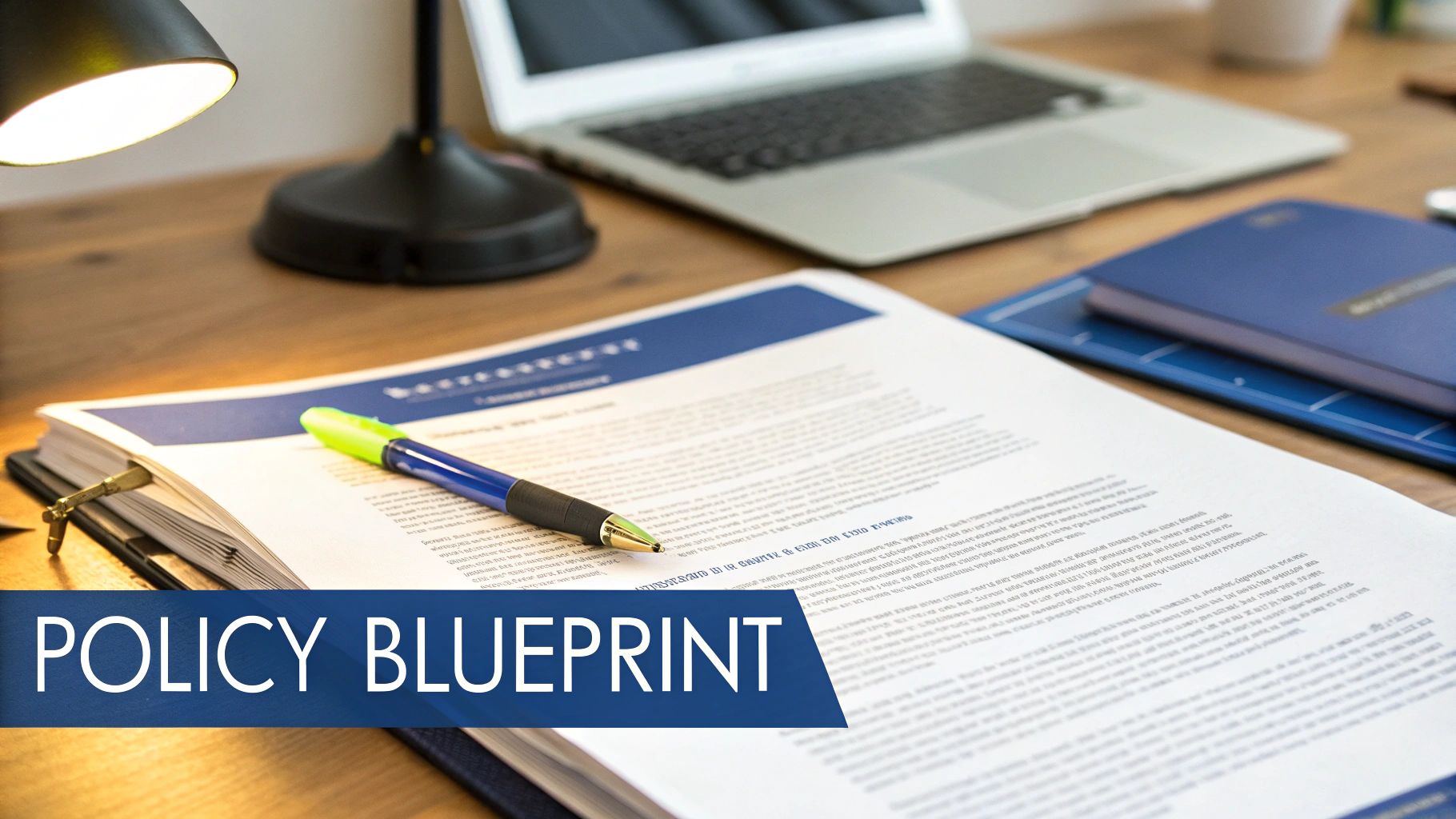
A commercial insurance policy is more than a legal document; it is a blueprint for your company’s financial recovery. For Texas businesses in sectors where hurricanes, floods, and winter storms are constant threats, understanding this blueprint is non-negotiable.
A policy is a carefully assembled package of specific coverages, limits, and exclusions that collectively define the scope of your financial protection.
For leaders in Manufacturing or Logistics, the value of an insurance policy is determined by how well it aligns with specific operational risks. The first step is to deconstruct the core components that form the foundation of most insurance natural disasters protection.
Core Coverage Types for Texas Operations
An insurance policy is structured around key pillars, each designed to address a different type of loss—from damaged equipment to a complete operational shutdown. Understanding these distinctions is crucial for identifying potential gaps in coverage.
Commercial Property Insurance: This is the foundation, protecting physical assets—buildings, equipment, inventory, and machinery—from direct damage caused by covered perils like fire or high winds. For a Texas agricultural business, this covers damage to a processing plant from a tornado.
Business Interruption (BI) Insurance: Also known as Business Income insurance, this coverage is vital for operational continuity. If a covered disaster forces a temporary shutdown, BI can replace lost income and cover ongoing expenses like payroll and rent, providing financial stability during recovery.
Contingent Business Interruption (CBI) Insurance: This extends coverage to income losses resulting from a disaster impacting a key supplier or customer, even if your own facility is undamaged. For a petrochemical plant on the Gulf Coast, CBI could cover financial losses if its primary logistics partner is incapacitated by a hurricane.
Understanding Key Policy Mechanics
Beyond coverage types, it is essential to understand how a policy functions. Three key terms govern the financial outcome following a disaster: deductibles, limits, and exclusions.
A deductible is the amount a business must pay out-of-pocket before the insurer’s contribution begins. In hurricane-prone regions of Texas, policies often include separate, higher percentage-based deductibles for named storms, which represents a significant upfront cost that must be factored into financial planning.
Coverage limits represent the maximum amount an insurer will pay for a single covered loss. If a manufacturing facility is insured for $5 million but sustains $7 million in damage from a storm, the business is responsible for the $2 million gap, in addition to the deductible.
What isn't covered is as important as what is. Standard commercial policies almost universally exclude damage from floods and earthquakes. For Texas businesses, particularly those located in a floodplain, a separate, dedicated flood policy or a specific endorsement is necessary to protect against water damage.
Familiarity with these concepts enables more strategic discussions with insurance professionals. The industry relies heavily on sophisticated data to set these terms; you can gain insight into how insurers use advanced analytics for risk assessment in our detailed guide.
Pinpointing Your Business's True Disaster Vulnerabilities
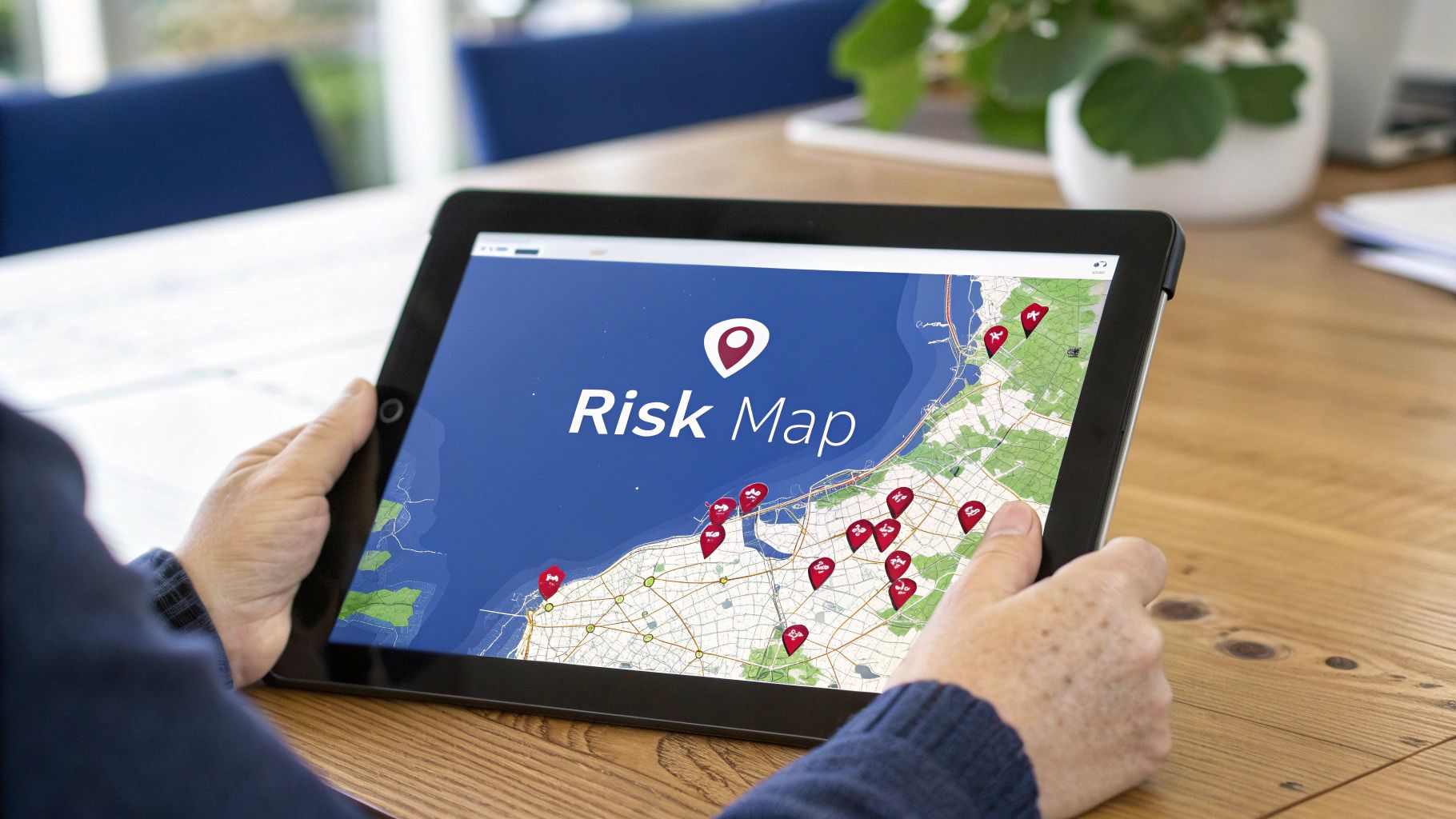
Before structuring insurance coverage, a business must conduct a thorough assessment of its unique operational exposures. A generic approach is insufficient. A Gulf Coast energy company faces a fundamentally different hurricane risk profile than a construction firm in North Texas concerned with tornadoes and hail.
Effective protection begins with a methodical risk assessment. This analysis extends beyond the physical facility to map every potential point of failure, from distant suppliers to the local power grid.
A proper assessment elevates the conversation from a vague "what if?" to a concrete "what is our plan when."
Evaluating Core Operational Exposures
For any Texas business, a natural disaster’s impact extends far beyond physical damage. Operational continuity depends on a complex network of systems, and an extreme weather event can sever critical connections instantly.
Each vulnerability point must be evaluated independently:
Physical Asset Risk: This includes direct damage to buildings, machinery, and inventory. Examples include a tornado damaging a farm's grain silos or a flash flood inundating a logistics warehouse.
Supply Chain Dependencies: An operation is only as resilient as its weakest link. A winter storm that ices over I-35 can halt a factory untouched by the weather itself by cutting off its supply of critical components.
Workforce and Infrastructure Access: Business continuity is threatened when power is out for an extended period or when impassable roads prevent employees from reaching the facility. If local infrastructure fails, so does the business.
A critical mistake is underestimating the interconnectedness of these risks. Winter Storm Uri was a case study in this phenomenon, proving that infrastructure failure can cause far greater financial damage from business interruption than a storm's direct physical impact.
Building a Data-Driven Risk Profile
A robust risk profile is not based on guesswork. It is developed by layering historical climate data, geographic information, and asset-specific details to model the potential impact of an event on your operations. This process involves modeling what another Hurricane Harvey would do to your business as it stands today.
This detailed analysis translates abstract threats into quantifiable financial and operational impacts. Our guide to effective risk assessment methodologies outlines frameworks for this process.
This profile becomes the foundation for subsequent decisions, from making resilience investments to structuring insurance coverage. Without it, strategic planning occurs in a vacuum.
Risk Assessment Matrix for Key Texas Industries
Every industry in Texas has a distinct risk profile. The following table outlines some of the most common threats and their likely impact on major sectors across the state.
| Industry Sector | Primary Texas Risk (e.g., Hurricane, Flood) | Key Operational Impact (e.g., Supply Chain Disruption) | Potential Asset Damage (e.g., Facility, Equipment) |
|---|---|---|---|
| Energy & Petrochemical | Hurricane, Flooding, Winter Storms | Plant shutdowns, logistics disruption | Refinery equipment, storage tanks, pipelines |
| Agriculture | Drought, Hail, Tornadoes | Crop failure, livestock loss | Barns, silos, irrigation systems, processing facilities |
| Manufacturing | Tornadoes, Winter Storms, Flooding | Supply chain failure, power outages | Production lines, robotics, inventory |
| Real Estate & Construction | Hail, High Winds, Flooding | Project delays, site access issues | Buildings under construction, materials, heavy equipment |
| Logistics & Transportation | Flooding, Winter Storms (Ice) | Road closures, port disruptions | Warehouses, vehicle fleets, distribution centers |
This matrix illustrates how a single event, such as a hurricane, can trigger vastly different consequences depending on the industry. Understanding these specific vulnerabilities is the first step toward building a truly resilient operation.
Disclaimer: The information provided is for educational purposes and does not constitute financial advice. ClimateRiskNow does not sell insurance products.
What Drives Your Insurance Costs?
Determining natural disaster insurance premiums is not arbitrary; it is a data-driven calculation of risk. For Texas businesses—especially in sectors like construction and manufacturing—insurers are constantly evaluating two questions: "What is the probability this business will suffer a loss?" and "How severe could that loss be?"
Physical location is the single most significant factor. A petrochemical facility on the Gulf Coast has a vastly different hurricane risk profile than a factory in North Texas, and that difference is reflected directly in premium pricing. Your industry also matters. Insurers possess decades of data on how specific sectors are affected, from crop damage in agriculture to fleet losses in logistics.
The financial exposure is increasing annually. The economic toll of natural disasters has escalated, climbing from an average of $70-$80 billion per year in the late 20th century to $180-$200 billion annually today. When indirect effects are included, the total cost now exceeds $2.3 trillion per year. You can see the full breakdown of global disaster costs in this detailed report.
From Passive Policyholder to Active Risk Manager
While a facility’s location cannot be changed, businesses are not powerless. The most effective lever for controlling insurance costs is proactive risk mitigation. Insurers often provide more favorable terms to businesses that take demonstrable steps to protect their assets.
An insurer's goal is to predict and price risk. When a business provides documented proof of resilience—such as reinforced buildings or a tested business continuity plan—it alters its risk profile, becoming a more favorable, and potentially less expensive, entity to insure.
This requires a shift in mindset. Instead of passively accepting a quote, a business can engage in a strategic conversation with underwriters, armed with data that validates its lower-risk status.
A Tale of Two Construction Companies
Consider two construction firms in a hurricane-prone area of Texas, both requiring windstorm coverage.
- Company A meets the minimum requirements. It complies with local building codes, uses standard material tie-downs, and has a basic written evacuation plan.
- Company B implements enhanced measures. It invests in hurricane-rated building materials and advanced anchoring systems for heavy equipment. It maintains a detailed, documented business continuity plan that is drilled regularly. It also uses sophisticated data to model storm impacts on its projects.
Company B consistently receives more favorable insurance terms. By investing in tangible resilience, it has demonstrably lowered the probability of a catastrophic loss. This is a fact an underwriter can quantify and reward with better premiums, as it signals a sophisticated approach to risk management.
For a closer look at how underwriters process this information, read our guide on how data analytics for insurance shapes risk assessment.
A Step-By-Step Guide to the Claims Process
When a natural disaster impacts your business, time is of the essence. The actions taken in the first 48 hours can significantly influence the outcome of your insurance claim. A clear, pre-established plan is your most valuable asset for a timely and efficient recovery.
The immediate priority, once the area is safe, is damage control. It is critical to prevent the situation from worsening, a concept insurers refer to as mitigating further loss. This may involve placing a tarp on a damaged roof to prevent water intrusion or boarding up broken windows to secure the building. Failure to take these reasonable steps can complicate a claim.
The Critical First Steps
After securing the site, the focus must shift to documentation and communication. Precision is paramount; this is not a time for estimations. A logistics company dealing with a flood, for example, should photograph everything from the water line on warehouse walls to the serial numbers on submerged equipment before anything is moved.
Here is a roadmap for those crucial initial hours:
- Document Everything: Use a smartphone to take extensive photos and videos from multiple angles. Create a detailed inventory of every damaged item, noting model numbers, purchase dates, and estimated value.
- Notify Your Insurer Immediately: Contact your agent or the carrier's claims hotline without delay. This officially opens your claim and places you in the queue for an adjuster. Following a major storm, adjusters are in high demand, and early notification is key.
- Organize Your Paperwork: Consolidate your insurance policies, property leases or deeds, and any existing inventories of business assets. Centralizing this documentation will dramatically expedite the claims process.
Navigating the Claims Journey
Once your claim is filed, the insurance company will assign an adjuster to your case. The adjuster's role is to inspect the damage and calculate the value of your loss based on the terms of your policy. The detailed documentation you created now serves as your primary tool for substantiating the claim and justifying the financial figures.
Of course, the entire process is influenced by the insurer's perception of your business's risk profile, which is established long before a storm occurs.
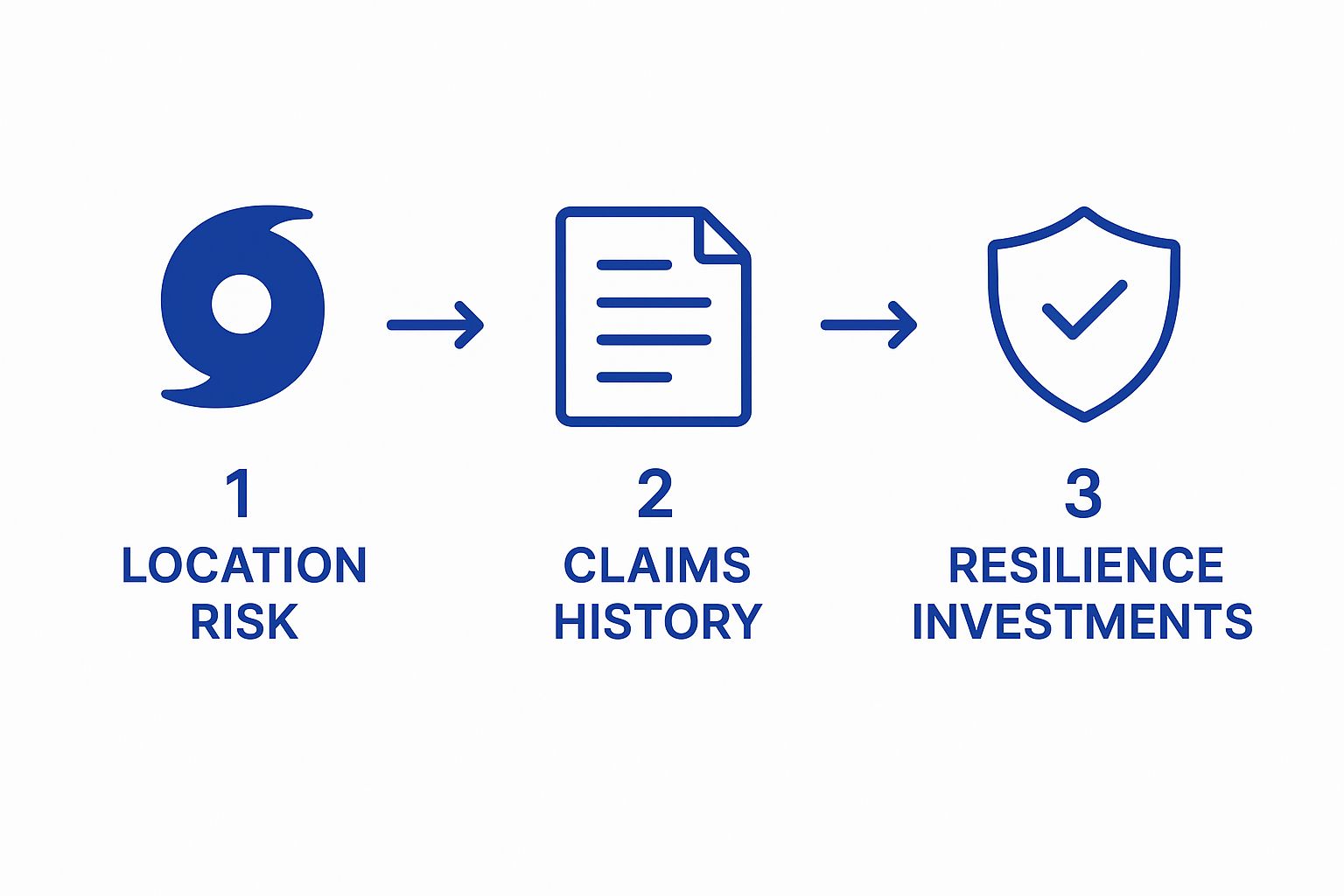
As illustrated, while location is fixed, your claims history and investments in property resilience directly impact your risk profile. For a deeper understanding of the assessment and repair process, this guide to storm damage roof repair and navigating insurance offers an excellent resource.
Disclaimer: The information in this guide is for educational purposes only. ClimateRiskNow does not sell insurance or provide financial advice, and business leaders should always consult with qualified professionals.
Building a Resilient Business Beyond Insurance
While robust insurance for natural disasters is a critical financial backstop, it is inherently a reactive tool. It provides capital after a loss has occurred but cannot prevent operational downtime, protect brand reputation, or repair a fractured supply chain.
True business resilience requires a proactive strategy, with insurance being just one component of a comprehensive risk management framework.
Relying solely on an insurance policy is insufficient. The primary goal should be to reduce the underlying operational risk to a degree that the likelihood of a catastrophic claim is minimized. This approach shifts a business from a posture of recovery to one of readiness and strength.
Recent data underscores the financial stakes. In the first half of 2023, global economic losses from natural disasters were estimated at $194 billion, with only $50 billion covered by insurance. This period included 17 separate billion-dollar events, highlighting the intensity and cost of modern catastrophes.
From Financial Backstop to Operational Armor
Building genuine resilience involves investing in proactive measures that physically and operationally harden a business against threats. These tangible actions not only protect assets but can also lead to more favorable insurance terms by demonstrating to underwriters that you operate a lower-risk entity.
Consider these strategic pillars:
- Infrastructure Hardening: This involves physical upgrades to facilities. For a Texas business, this could mean reinforcing a roof to withstand hail, elevating critical equipment above potential flood levels, or installing hurricane-rated windows.
- Supply Chain Diversification: Map critical suppliers and identify alternatives in different geographic regions. This reduces the risk that a single hurricane or flood could disrupt your entire supply chain.
- Robust Business Continuity Planning (BCP): A BCP is an operational playbook for navigating a disaster. It extends beyond a simple evacuation plan to cover data backups, remote work protocols, and crisis communication strategies.
Ultimately, proactive mitigation is an investment in operational continuity. By reducing your vulnerability, you protect your revenue streams and market position—assets that no insurance policy can ever fully replace.
Tangible Steps for Texas Industries
For Texas businesses in sectors like manufacturing or construction, these strategies have immediate, practical applications. Beyond financial coverage, physical preparedness is essential. Simple measures like boarding up windows for hurricane protection can prevent cascading interior damage from high winds and rain.
By integrating these measures, you fundamentally transform your risk profile. To develop a structured approach, our guide on creating a comprehensive business resilience framework offers an actionable roadmap for Texas decision-makers. This proactive stance is key to building a business that not only survives disasters but is positioned to thrive in an era of increasing climate volatility.
Frequently Asked Questions
The following are answers to common questions Texas business leaders have about navigating insurance for natural disasters.
Does My Standard Commercial Property Policy Cover Flood Damage?
Almost certainly not. A standard commercial property policy is designed to cover numerous perils, but flood damage is a near-universal exclusion. Given the significant flood risk across Texas, a separate, dedicated flood insurance policy or a specific endorsement to your primary policy is typically required. The only way to confirm coverage is to review your policy documents line by line with a qualified insurance professional.
How Does Business Interruption Insurance Actually Work After a Disaster?
Business Interruption (BI) coverage is designed to replace lost income and cover ongoing expenses—such as payroll or rent—if physical damage from a covered peril forces a temporary shutdown. However, coverage does not begin immediately. Nearly every policy includes a waiting period, often 72 hours, before benefits become payable. Coverage then continues for a pre-defined "period of restoration," which is the contractually specified time allotted for the business to resume operations.
Can We Lower Our Premiums by Investing in Risk Mitigation?
Yes, proactive risk mitigation can have a material impact on insurance costs. Insurers view these investments as an indicator of a lower-risk client. Actions such as installing hail-resistant roofing, elevating critical electrical equipment above flood levels, or maintaining a well-documented and tested business continuity plan can directly improve your risk profile and potentially lower your premiums. When you reduce an insurer's potential loss, you become a more attractive risk to underwrite.
Disclaimer: The information provided is for educational purposes only. ClimateRiskNow does not sell insurance or provide financial advice.
Transform complex weather data into actionable risk management strategies. ClimateRiskNow delivers location-specific intelligence to help Texas businesses safeguard assets and ensure operational continuity.

